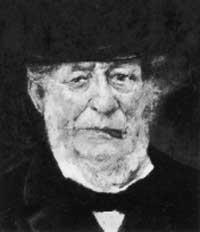Robert Wilhelm von Bunsen
German chemist born in Göttingen on 31 March 1811. He studied in his own hometown, where he obtained his doctorate in chemistry in 1830.
He travelled to France, Germany and Austria until he decided to join the teaching. In 1836 he was professor of chemistry at the Polytechnic Institute of Kassel and in 1838 he obtained a professorship at the University of Marburg. He also taught at Breslau, and when Gmelin died in 1852 he was given his place at the University of Heidelberg.
In 1834 he discovered hydrated iron oxide (III) or arsenic antidote.
He did his first research between 1837 and 1842. He studied the organic compounds of arsenium and his works served in XX. At the beginning of the century Paul Ehrlich successfully developed chemotherapy. During Buns' investigation, the laboratory suffered an explosion and lost an eye. In addition, due to arsenic slowly breathed into its work, it was poisoned almost to death. From the completion of his research he did not work in organic chemistry.

In 1841, Bunsen obtained a pile of coal and zinc, and in 1844, a photometer capable of measuring light by a stain of fat.
He also studied the gases generated in the furnaces and suggested methods to partially reduce heat losses. He found that between 50 and 80 percent of the heat was wasted and released the results of his research in a single book, Gasometrische Methoden (1857).
He also invented new gas analysis systems. He also invented the device to measure the solubility of gases, the speed of gas output, the ice calorimeter (in 1870) and the steam calorimeter (in 1887). Continuing with the thread of this topic, he began to study the geysers of Iceland around 1850, giving detailed explanations.
He was the first to obtain metallic magnesium (1851). Studying its physical and chemical characteristics, he found that in the air it produced a very bright light. That is why it was used much later in photography. In 1855-1863, in collaboration with Roscoe, he carried out tests on the chemical effect of light.
However, his most famous invention is the lighter with hole in the bottom so that the air mixes with the gas that will burn. The gas/air mixture has a hot, dark, smokeless flame and no one working in the chemical laboratory of any school can't remember the Bunsen lighter, but the truth is that before Bunsen Faraday had already used something similar.
In 1859 Bunsen began experimenting with Kirchhoff in the field of spectroscopy and in 1860 spectroscope was invented. The lines appearing in the spectrum showed that each chemical element has its own and peculiar, and immediately identified the new chemical elements called cessions and rubidities. Then other scientists would use it to study the kneading of spectroscopy.
In Buns he did not marry in his life and he said that the reason was lack of time. He died in Heidelberg on August 16, 1899.
Buletina
Bidali zure helbide elektronikoa eta jaso asteroko buletina zure sarrera-ontzian











